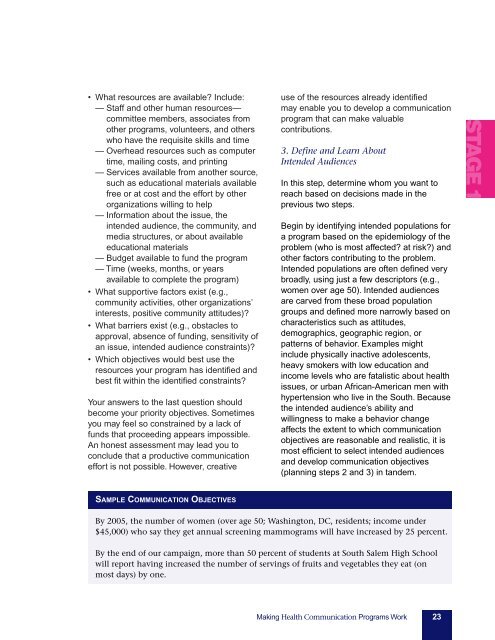pink-book
pink-book
pink-book
You also want an ePaper? Increase the reach of your titles
YUMPU automatically turns print PDFs into web optimized ePapers that Google loves.
• What resources are available Include:<br />
— Staff and other human resources—<br />
committee members, associates from<br />
other programs, volunteers, and others<br />
who have the requisite skills and time<br />
— Overhead resources such as computer<br />
time, mailing costs, and printing<br />
— Services available from another source,<br />
such as educational materials available<br />
free or at cost and the effort by other<br />
organizations willing to help<br />
— Information about the issue, the<br />
intended audience, the community, and<br />
media structures, or about available<br />
educational materials<br />
— Budget available to fund the program<br />
— Time (weeks, months, or years<br />
available to complete the program)<br />
• What supportive factors exist (e.g.,<br />
community activities, other organizations’<br />
interests, positive community attitudes)<br />
• What barriers exist (e.g., obstacles to<br />
approval, absence of funding, sensitivity of<br />
an issue, intended audience constraints)<br />
• Which objectives would best use the<br />
resources your program has identified and<br />
best fit within the identified constraints<br />
Your answers to the last question should<br />
become your priority objectives. Sometimes<br />
you may feel so constrained by a lack of<br />
funds that proceeding appears impossible.<br />
An honest assessment may lead you to<br />
conclude that a productive communication<br />
effort is not possible. However, creative<br />
use of the resources already identified<br />
may enable you to develop a communication<br />
program that can make valuable<br />
contributions.<br />
3. Define and Learn About<br />
Intended Audiences<br />
In this step, determine whom you want to<br />
reach based on decisions made in the<br />
previous two steps.<br />
Begin by identifying intended populations for<br />
a program based on the epidemiology of the<br />
problem (who is most affected at risk) and<br />
other factors contributing to the problem.<br />
Intended populations are often defined very<br />
broadly, using just a few descriptors (e.g.,<br />
women over age 50). Intended audiences<br />
are carved from these broad population<br />
groups and defined more narrowly based on<br />
characteristics such as attitudes,<br />
demographics, geographic region, or<br />
patterns of behavior. Examples might<br />
include physically inactive adolescents,<br />
heavy smokers with low education and<br />
income levels who are fatalistic about health<br />
issues, or urban African-American men with<br />
hypertension who live in the South. Because<br />
the intended audience’s ability and<br />
willingness to make a behavior change<br />
affects the extent to which communication<br />
objectives are reasonable and realistic, it is<br />
most efficient to select intended audiences<br />
and develop communication objectives<br />
(planning steps 2 and 3) in tandem.<br />
STAGE 1<br />
SAMPLE COMMUNICATION OBJECTIVES<br />
By 2005, the number of women (over age 50; Washington, DC, residents; income under<br />
$45,000) who say they get annual screening mammograms will have increased by 25 percent.<br />
By the end of our campaign, more than 50 percent of students at South Salem High School<br />
will report having increased the number of servings of fruits and vegetables they eat (on<br />
most days) by one.<br />
Making Health Communication Programs Work 23


